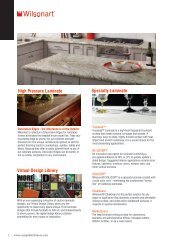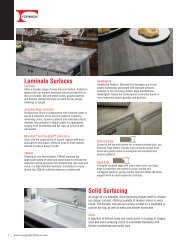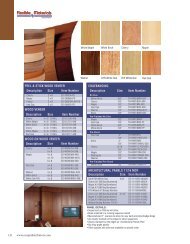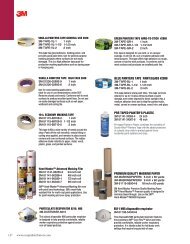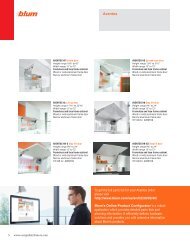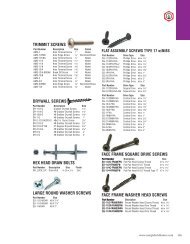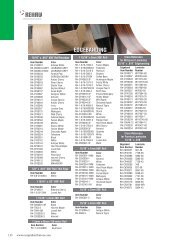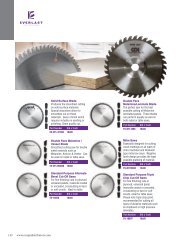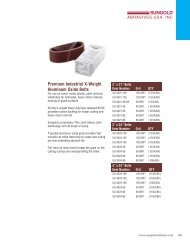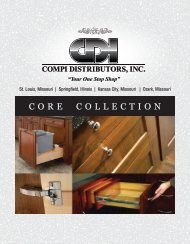CDI CORE CATALOG F
- No tags were found...
You also want an ePaper? Increase the reach of your titles
YUMPU automatically turns print PDFs into web optimized ePapers that Google loves.
Using the brochure<br />
Blum's Concealed hinges brochure makes it easy to use our Euro hinges. Each page shows information for both face frame and panel applications.<br />
The top row shows the hinge in a face frame cabinet and the center row shows it in a panel cabinet. The bottom holds the overlay/reveal tables<br />
and hinge part numbers.<br />
Hinges<br />
CLIP top BLUMOTION 110°<br />
Minimum reveal<br />
To determine the minimum reveal, use the table in the upper right<br />
hand corner of each page.<br />
Face frame construction<br />
To use Euro hinges in a face frame cabinet, use the top row.<br />
Overlay<br />
Frame<br />
H<br />
Features<br />
BLUMOTION integrated into the hinge cup<br />
Deactivation switch for small/light doors<br />
For door thicknesses up to 26 (1")<br />
Overload safety feature<br />
86° angle restriction clip available (70T3553)<br />
Compatible with existing CLIP mounting<br />
plates and hinge arm cover caps<br />
Partial/twin overlay<br />
Frame<br />
H<br />
Inset<br />
Frame<br />
Minimum reveal table<br />
3 0.5 1.0 1.8 2.7 4.3<br />
4 0.5 1.0 1.7 2.5 3.8<br />
5 0.5 0.9 1.7 2.4 3.4<br />
6 0.5 0.9 1.6 2.3 3.2<br />
7 0.5 0.9 1.6 2.2 3.0<br />
B = 16 19 22 24 26<br />
boring<br />
T = door thickness<br />
distance<br />
Thickness greater than 26 trial recommended<br />
H = 9<br />
66.5<br />
66.5<br />
67.5<br />
14<br />
min.<br />
Panel construction<br />
To use Euro hinges in a panel cabinet, use the center row.<br />
Panel<br />
T<br />
13<br />
H<br />
W<br />
B<br />
overlay<br />
Panel<br />
NOTE: Application requires a half-cranked<br />
hinge and mounting plate 175H5030.21<br />
Panel<br />
H = 0<br />
66.5<br />
T<br />
13<br />
H<br />
W<br />
B<br />
overlay<br />
H<br />
B<br />
reveal<br />
66.5<br />
68<br />
T<br />
13<br />
Overlay and reveal tables<br />
To determine the overlay and reveals, use the tables at the bottom of<br />
each column.<br />
T<br />
13<br />
37<br />
B<br />
overlay<br />
H Overlay P S<br />
T<br />
13<br />
B<br />
reveal<br />
37<br />
H Overlay P S<br />
T<br />
13<br />
H Reveal P S<br />
B<br />
reveal<br />
T + 38.5<br />
0 14 15 16 17 18 12 21.5<br />
0 4.5 5.5 6.5 7.5 8.5 21.5 31<br />
0 4 3 2 1 – 30 39.5<br />
Select hinge<br />
Select the appropriate hinge from the bottom of each column. Screw-on,<br />
press-in, EXPANDO and INSERTA are available for most hinges.<br />
3 11 12 13 14 15 15 24.5<br />
4.5 9.5 10.5 11.5 12.5 13.5 16.5 26<br />
6 8 9 10 11 12 18 27.5<br />
9 5 6 7 8 9 21 30.5<br />
3 4 5 6 7 Fixed<br />
distance<br />
B = boring distance = 11<br />
NOTE: 4.5 plate is only for use in frame<br />
cabinets, 9 plate is only for panel cabinets<br />
3 4 5 6 7 Fixed<br />
distance<br />
B = boring distance = 1.5<br />
H Reveal W P S<br />
0<br />
7 5 3 1 – 16<br />
10 8 6 4 2 19<br />
13 11 9 7 5 22<br />
3 4 5 6 7<br />
B = boring distance<br />
21.5 31<br />
9 4.5 3.5 2.5 1.5 0.5 30.5 40<br />
3 4 5 6 7 Fixed distance:<br />
0 = -7<br />
B = boring distance 9 = 1.5<br />
Abbreviations<br />
H = Plate height<br />
P = Door protrusion<br />
S = Side arm protrusion<br />
W = Side panel width<br />
Straight-arm<br />
Self close<br />
Half-cranked<br />
Self close<br />
Full-cranked<br />
Self close<br />
Screw-on<br />
71B3550<br />
Screw-on<br />
71B3650<br />
Screw-on<br />
71B3750<br />
Press-in<br />
71B3580<br />
Press-in<br />
71B3680<br />
Press-in<br />
71B3780<br />
INSERTA<br />
71B3590<br />
INSERTA<br />
71B3690<br />
INSERTA<br />
71B3790<br />
EXPANDO<br />
71B358E<br />
Step-by-step – the following example is based on a panel cabinet with an overlay<br />
Step 1 – Determine cabinet construction<br />
Face frame<br />
Panel<br />
Step 2 – Determine the overlay or reveal<br />
Overlay Partial/twin overlay Inset<br />
overlay<br />
reveal<br />
reveal<br />
Step 3 – Find boring distance and mounting plate height<br />
Based on your overlay use the<br />
table to determine the mounting<br />
plate height and boring distance<br />
needed.<br />
H = 0<br />
B = 6<br />
overlay = 17<br />
7 www.compidistributors.com<br />
H Overlay P S<br />
0 14 15 16 17 10 21<br />
3 11 12 13 14 13 24<br />
4.5 9.5 10.5 11.5 12.5 14.5 25.5<br />
6 8 9 10 11 16 27<br />
9 5 6 7 8 19 30<br />
3 4 5 6 fixed<br />
distance<br />
B = boring distance = 11<br />
NOTE: 4.5 plate is only for use<br />
in face frame cabinets, 9 plate<br />
is only for panel cabinets<br />
Step 4 – Check minimum reveal table<br />
All minimum reveal tables are<br />
Minimum reveal table<br />
based on square edge door with<br />
a 1 mm radius. A larger radius<br />
or profile door will change the<br />
minimum reveal required.<br />
3<br />
4<br />
5<br />
6<br />
0.6<br />
0.6<br />
0.6<br />
0.6<br />
1.0<br />
1.0<br />
1.0<br />
1.0<br />
1.3<br />
1.3<br />
1.2<br />
1.2<br />
1.7<br />
1.6<br />
1.5<br />
1.4<br />
2.5<br />
2.4<br />
2.2<br />
2.0<br />
B = 16 18 19 20 22<br />
1 rad<br />
boring<br />
(1/ 32 ")<br />
Trial application recommended<br />
distance T = door thickness<br />
19<br />
minimum reveal



